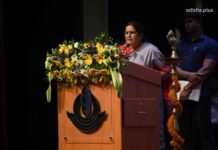By Sanjeev K. Patro & Nilambar Rath
As per the National Family Health Survey-5 (NFHS-5) report released recently, the sexual behavior of men and women in Odisha has undergone a change during the last 5 years

The three lettered S** word that has always been wrapped up in layers of secrecy, beeps on a ‘high risk’ casual behaviour ringing an alarm bell for Odisha on the World Sexual Health Day observed on September 4.
The ‘high-risk’ sounds startling when Monkey pox is threatening countries across the globe.
As per the National Family Health Survey-5 (NFHS-5) report released recently, the sexual behavior of men and women in Odisha has undergone a change during the last 5 years.
High risk sex among urban men and women has posted a rise in the State. NFHS-5 has also sniffed a rise in sexual activity in the age group of 15-24 years in the urban areas.
NFHS-5 describes high-risk sex as a sexual intercourse with someone who is neither spouse nor cohabiting partner. This shows ‘casual sex’ is on rise in the State.
Unsafe Trend
Significantly, when WHO has made “Let’s Talk Pleasure” this year’s theme of World Sexual Health Day, the red herring for the State is, as per NFHS-5, nearly 65 percent of such individuals don’t have safe sex. The NFHS-5, therefore, points to a rising trend of ‘casual’ and ‘unsafe’ sex among the very youth population in the State.
Because, the Survey has put a glare on the changing sexual behavior of urban men in the age group of 15-24 yrs in the period of 2019-21. A comparative analysis when was done with the prevalent behavior in 2015-16, tells a big tale. (Table is given below)
| Sexual Behaviour | 2019-21
Men |
2019-21
Women |
2019-21
Total |
2015-16
Men |
2015-16
Women |
2015-16
Total |
| % who have ever had sexual intercourse | 7.8 | 25.3 | 16.9 | 7.2 | 30.4 | 20.4 |
| % Who had sexual intercourse before the age of 15 | 0.0 | 0.4 | 0.2 | 0.0 | 2.0 | 1.1 |
While sexual activity among the urban teen men in the State has shown a rise in 2019-21, a drop is recorded among the female teens over the years. But the drop in the activity among urban females is attributed to the rise in median age at first marriage to 20.2 yrs from 19.9 in 2015-16. Take a look at the table given below
| % women first married by age | 2019-21
15-19 years |
2019-21
20-24 years |
2015-16
15-19 years |
2015-16
20-24 years |
| Urban +Rural | 1.0 | 2.4 | 1.8 | 3.5 |
A glance at the data over the two periods shows a drop in proportion of women going for early marriage (before 24 yrs) in 2019-21 vis-a-vis 2015-16.
Odisha Dialing STD?
While State Health Department data shows detection of a whopping 1.06 lakh sexually transmitted/reproductive tract infections (diseases) in 2020-21, in gonococcal infections, State is at number seven among 32 states/UTs.
Mirroring the trend of rise in ‘casual’ and ‘unsafe’ sex among males below 24 years, the cases of this sexually transmitted disease detected in males had doubled to 1735 in 2020. A corresponding decline has been observed among females.
Significantly, as per WHO, though symptoms of this bacterial disease manifests between 2-30 days, however, there have been cases where the symptoms manifestation take weeks time or may not became apparent at all.
The worry of this STD is if untreated for a long time, it will trigger infertility.
Another Facet
The World Health Organization has flagged high teenage or unwanted pregnancies and abortions also as indicators of poor sexual health prevailing in the society.
During the last half a decade, the teenage pregnancies in Odisha didn’t show any drop. In every 100 girls in the age-group of 15-17 years, 8 have been reported pregnant, finds the NFHS-5. The survey added that the proportion rises to 21 per 100 at the age of 19 years.
Significantly, the survey results found the rate of abortion in the range of 2.0- 8.9 percent. And half of the respondents attributed the reason behind as unplanned pregnancy.
When WHO listed sexual violence an anathema of good sexual health, 5 in every 100 women are faced with sexual violence every year in the State.
Sexual Health Care Services
Under the National Health Mission, Adolescent Friendly Health Centres (AFHC) have been opened at the district level by state governments. Launched in 2006, the centres were catering to sexual and reproductive health issues of adolescents. But since 2014, these centres provide services on nutritional issues along with sexual health.
In Odisha, 145 AFHCs have been opened in 30 districts. The data with State Health Department reveals that a total of 62,673 adolescents had visited the centres in 2020-21.
Significantly, around 78 percent of the attendees have received clinical treatment. As per health department report, while cases of RTI (reproductive tract infection) have been recorded higher in females, males record higher STI (sexually transmitted infections).
Significantly, a detailed glance shows that adolescent girls registered in the centres are higher than boys, when NFHS-5 survey finds high risk behavior high in males.
Moreover, the health department data further reveals that during Ante Natal check-ups, a high number of 1.49 lakh pregnant women were diagnosed with STI – Syphilis.
The above data clearly hints at non-reporting of STIs by patriarchal households in the State, because STIs are mainly transmitted from ‘high-risk’ behavioral males to females.
Experts Take
Speaking to SwasthyaPlus, a multilingual digital health awareness platform, Sydney-based sexual & reproduction health physician Dr Nivedita Manokaran, said, “There are two types of STIs one by transmission via sexual intercourse and the other happens through skin-to-skin contact (basically by viruses).”
She adds that the infected may not have symptoms for long, only testing will detect the type of infection. “In case of infections spread through skin contact, antibody tests are done to diagnose the type of infection,” observes Dr Nivedita.
Monkeypox Era And Sexual Health
Detected first in 1958 in African countries, this viral STI transmits through sexual intercourse or even via skin contact like hugging, kissing and massaging.
However, WHO has recently declared the outbreak of this disease as a public health emergency of international concern (PHEIC). Till mid August, India had reported 8 monkeypox cases and 1 death.
Bottomline
As NFHS-5 and health department data have given insights on the behavior of, and STI load among sexually active populace in the State, the secrecy wrap on sex needs to be broken and be treated as health and wellness subject, especially when Monkeypox transmission is on.
Tags: Sexual Health, World Sexual Health Day, Lets Talk Pleasure, NFHS-5, Safe Sex, Unsafe Sex, Monkey Pox

























